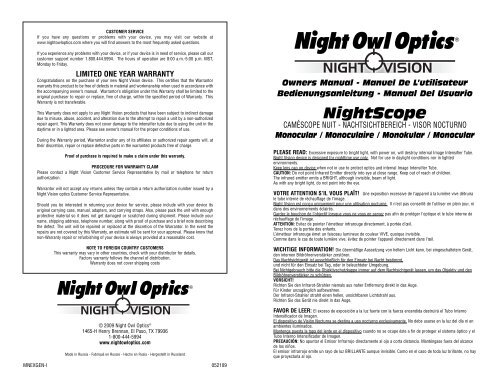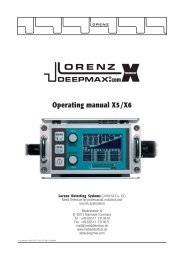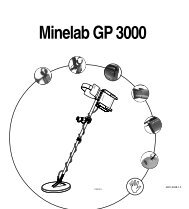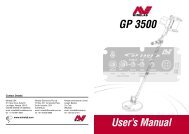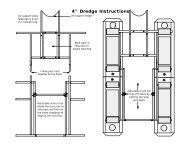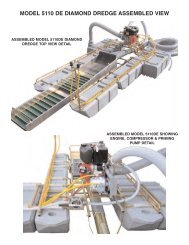NightScope - Night Owl Optics
NightScope - Night Owl Optics
NightScope - Night Owl Optics
Create successful ePaper yourself
Turn your PDF publications into a flip-book with our unique Google optimized e-Paper software.
CUSTOMER SERVICE<br />
If you have any questions or problems with your device, you may visit our website at<br />
www.nightowloptics.com where you will find answers to the most frequently asked questions.<br />
If you experience any problems with your device, or if your device is in need of service, please call our<br />
customer support number 1.800.444.5994. The hours of operation are 8:00 a.m.-5:00 p.m. MST,<br />
Monday to Friday.<br />
LIMITED ONE YEAR WARRANTY<br />
Congratulations on the purchase of your new <strong>Night</strong> Vision device. This certifies that the Warrantor<br />
warrants this product to be free of defects in material and workmanship when used in accordance with<br />
the accompanying owner’s manual. Warrantor’s obligation under this Warranty shall be limited to the<br />
original purchaser to repair or replace, free of charge, within the specified period of Warranty. This<br />
Warranty is not transferable.<br />
This Warranty does not apply to any <strong>Night</strong> Vision products that have been subject to indirect damage<br />
due to misuse, abuse, accident, and alteration due to the attempt to repair a unit by a non-authorized<br />
repair agent. This Warranty does not cover damage to the intensifier tube due to using the unit in the<br />
daytime or in a lighted area. Please see owner’s manual for the proper conditions of use.<br />
During the Warranty period, Warrantor and/or any of its affiliates or authorized repair agents will, at<br />
their discretion, repair or replace defective parts in the warranted products free of charge.<br />
Proof of purchase is required to make a claim under this warranty.<br />
PROCEDURE FOR WARRANTY CLAIM<br />
Please contact a <strong>Night</strong> Vision Customer Service Representative by mail or telephone for return<br />
authorization.<br />
Warrantor will not accept any returns unless they contain a return authorization number issued by a<br />
<strong>Night</strong> Vision optics Customer Service Representative.<br />
Should you be interested in returning your device for service, please include with your device its<br />
original carrying case, manual, adapters, and carrying straps. Also, please pack the unit with enough<br />
protective material so it does not get damaged or scratched during shipment. Please include your<br />
name, shipping address, telephone number, along with proof of purchase and a brief note describing<br />
the defect. The unit will be repaired or replaced at the discretion of the Warrantor. In the event the<br />
repairs are not covered by this Warranty, an estimate will be sent for your approval. Please know that<br />
non-Warranty repair or refurbishing of your device is always provided at a reasonable cost.<br />
NOTE TO FOREIGN COUNTRY CUSTOMERS<br />
This warranty may vary in other countries, check with your distributor for details.<br />
Factory warranty follows the channel of distribution.<br />
Warranty does not cover shipping costs<br />
© 2009 <strong>Night</strong> <strong>Owl</strong> <strong>Optics</strong> ®<br />
1465-H Henry Brennan, El Paso, TX 79936<br />
1-800-444-5994<br />
www.nightowloptics.com<br />
Made in Russia - Fabriqué en Russie - Hecho en Rusia - Hergestellt in Russland<br />
MNEXGEN-I 052109<br />
Owners Manual - Manuel De L’utilisateur<br />
Bedienungsanleitung - Manual Del Usuario<br />
<strong><strong>Night</strong>Scope</strong><br />
CAMÉSCOPE NUIT - NACHTSICHTBEREICH - VISOR NOCTURNO<br />
Monocular / Monoculaire / Monokular / Monocular<br />
PLEASE READ: Excessive exposure to bright light, with power on, will destroy internal Image Intensifier Tube.<br />
<strong>Night</strong> Vision device is designed for nighttime use only. Not for use in daylight conditions nor in lighted<br />
environments.<br />
Keep lens cap on device when not in use to protect optics and internal Image Intensifier Tube.<br />
CAUTION: Do not point Infrared Emitter directly into eye at close range. Keep out of reach of children.<br />
The infrared emitter emits a BRIGHT, although invisible, beam of light.<br />
As with any bright light, do not point into the eye.<br />
VOTRE ATTENTION S’IL VOUS PLAÎT! Une exposition excessive de l’appareil à la lumière vive détruira<br />
le tube interne de réchauffage de l’image.<br />
<strong>Night</strong> Vision est conçu uniquement pour une utilisation nocturne. Il n’est pas conseillé de l’utiliser en plein jour, ni<br />
dans des environnements éclairés.<br />
Gardez le bouchon de l’objectif lorsque vous ne vous en servez pas afin de protéger l’optique et le tube interne de<br />
réchauffage de l’image.<br />
ATTENTION: Evitez de pointer l’émetteur infrarouge directement, à portée d’œil.<br />
Tenez hors de la portée des enfants.<br />
L’émetteur infrarouge émet un faisceau lumineux de couleur VIVE, quoique invisible.<br />
Comme dans le cas de toute lumière vive, évitez de pointer l’appareil directement dans l’œil.<br />
WICHTIGE INFORMATION! Die übermäßige Aussetzung von hellem Licht kann, bei eingeschaltetem Gerät,<br />
den internen Bildröhrenverstärker zerstören.<br />
Das Nachtsichtgerät ist ausschließlich für den Einsatz bei Nacht bestimmt,<br />
und nicht für den Einsatz bei Tag, oder in beleuchteter Umgebung.<br />
Bei Nichtgebrauch bitte die Objektivschutzkappe immer auf dem Nachtsichtgerät lassen, um das Objektiv und den<br />
Bildröhrenverstärker zu schützen.<br />
VORSICHT!<br />
Richten Sie den Infrarot-Strahler niemals aus naher Entfernung direkt in das Auge.<br />
Für Kinder unzugänglich aufbewahren.<br />
Der Infrarot-Strahler strahlt einen hellen, unsichtbaren Lichtstrahl aus.<br />
Richten Sie das Gerät nie direkt in das Auge.<br />
FAVOR DE LEER: El exceso de exposición a la luz fuerte con la fuerza encendida destruirá el Tubo Interno<br />
Intensificador de Imagen.<br />
El dispositivo de Visión Nocturna se destina a uso nocturno exclusivamente. No debe usarse en la luz del día ni en<br />
ambientes iluminados.<br />
Mantenga puesta la tapa del lente en el dispositivo cuando no se ocupe éste a fin de proteger el sistema óptico y el<br />
Tubo Interno Intensificador de Imagen.<br />
PRECAUCIÓN: No apuntar el Emisor Infrarrojo directamente al ojo a corta distancia. Manténgase fuera del alcance<br />
de los niños.<br />
El emisor infrarrojo emite un rayo de luz BRILLANTE aunque invisible. Como en el caso de toda luz brillante, no hay<br />
que proyectarla al ojo.
A<br />
B<br />
C<br />
MODELS / MODELES / MODELLE / MODELOS<br />
- Power Switch<br />
- Interrupteur d’alimentation<br />
- Ein/Aus Schalter<br />
- Interruptor de alimentacion<br />
- Infrared Illuminator Switch<br />
- Interrupteur de l’illuminateur<br />
a infrarouge<br />
- Infrarot-Beleuchtung<br />
Schalter<br />
- Interruptor del iluminador de<br />
infrarrojo<br />
- Infrared Illuminator<br />
- Illuminateur à infrarouge<br />
- Infrarot-Beleuchtung<br />
- lluminador del infrarrojo<br />
E<br />
A<br />
B<br />
F<br />
G<br />
G<br />
C<br />
D<br />
Cómo Funciona la Visión Nocturna<br />
La luz (como la de la luna o las estrellas) que llega al dispositivo proveniente del objeto se concentra<br />
en el lente del objetivo y se enfoca en el Tubo Intensificador de Imagen.<br />
La parte delantera del Tubo Intensificador de Imagen cuenta con un fotocátodo que transforma la luz<br />
en electrones.<br />
El dispositivo cuenta con una alimentación de fuerza de voltaje muy elevado que transforma los 3<br />
voltios de las pilas a 17 kilovoltios.<br />
El alto voltaje lanza los electrones a una pantalla de fósforo, misma que se ilumina con una imagen al<br />
recibir el choque de los electrones. El sistema óptico del ocular luego va enfocando la imagen de la<br />
pantalla de fósforo a su ojo.<br />
Iluminador de<br />
Infrarrojo (IR)<br />
Pantalla<br />
fotocatódica<br />
D<br />
E<br />
F<br />
G<br />
- Objective Lens<br />
- Lentille de l’objectif<br />
- Objektivlinse<br />
- Objetivo<br />
- Ocular<br />
- Oculaire<br />
- Okular<br />
- Ocular<br />
- Image Intensifier Tube<br />
- Tube de réchauffage de<br />
l’image<br />
- Bildröhrenverstärker<br />
- Tubo Intensificador De<br />
Imagen<br />
- Battery Compartment<br />
- Compartiment des piles<br />
- Batteriefach<br />
- Compartimiento de pilas<br />
E<br />
A<br />
E<br />
B<br />
F<br />
G<br />
C<br />
C<br />
D<br />
D<br />
Ocular<br />
Objeto<br />
Objetivo<br />
Electrones<br />
Pantalla<br />
fosforescente Intensificador Electrónico<br />
El Cuidado de su Dispositivo de Visión Nocturna<br />
Si va a guardar la unidad por más de 24 horas, es preferible retirarle las pilas.<br />
Guarde la unidad en un lugar fresco y seco.<br />
Limpie los lentes como lo hace con los lentes de su cámara fotográfica, con material de limpieza de<br />
lentes de tipo profesional.<br />
Los lentes cuentan con recubrimiento óptico, pudiendo rayarse si se usa material abrasivo o si se<br />
talla el cristal con tierra. Evite tocar la superficie de los lentes con los dedos.<br />
Evite las caídas y los choques. El Tubo Intensificador es de cristal.<br />
No desarme ni intente dar servicio al dispositivo. ¡La alimentación de fuerza en su interior genera<br />
17,000 voltios!<br />
Si el dispositivo necesita compostura, favor de consultar la tarjeta de garantía.<br />
No deje la unidad dentro de un automóvil en un día cálido y asoleado.<br />
Limpie el exterior con un paño suave y limpio.<br />
A<br />
B<br />
F<br />
Si se ve condensación en la unidad, llévela a una temperatura normal y espere hasta que desaparezca<br />
la condensación antes de usarla.<br />
2<br />
19
¿Cuándo puedo exponer la unidad a la luz?<br />
Para fines de demostración existe un pequeño agujero en la tapa del lente que le permite encender la<br />
unidad en la luz. Se puede retirar la tapa del lente con la luz del día pero la unidad deberá estar apagada.<br />
¿Qué es la Generación 1? ¿Cuál es la diferencia comparada con otras<br />
Generaciones de dispositivos de Visión Nocturna?<br />
Todas las Generaciones, 1, 2, 3 y 4, utilizan tecnología de bombardeo de electrones, misma que<br />
transforma la luz en electrones, reproduciendo la imagen en una pantalla de fósforo.<br />
La Generación 1 produce una imagen de mayor resolución que la Generación 2.<br />
Las Generaciones 3 y 4 son empleadas por las Fuerzas Militares de EE.UU. y son muy caras.<br />
Las Generaciones 2, 3 y 4 emplean un dispositivo de fibra óptica y/o químicos especiales en la<br />
mayor amplificación de la luz.<br />
Desempeño ante Diversas Condiciones de Luz<br />
Oscuridad Total<br />
Funciona su dispositivo de Visión Nocturna amplificando la luz natural disponible. En la oscuridad<br />
total, sin luz natural disponible, no se puede ver sin el uso del Iluminador Infrarrojo (IR), mismo<br />
que funciona como linterna, siendo invisible para el ojo humano y de los animales.<br />
Media Luna<br />
La media luna produce bastante luz ambiental, misma que amplifica el Tubo Interno Intensificador<br />
de Imagen. Sin el auxilio del IR, se puede reconocer un objeto del tamaño de un hombre a unas<br />
100 yardas de distancia.<br />
Un Cuarto de Luna<br />
Un cuarto de luna produce una luz ambiental mínima que permite ver sin el auxilio del IR. Sin<br />
iluminar con el IR, se puede reconocer un objeto del tamaño de un hombre a unas 60 yardas de<br />
distancia. Iluminando con el IR, dicha distancia se incrementa a más de 100 yardas. El IR mejora<br />
mucho el reconocimiento del blanco.<br />
Ambiente Urbano (con fuentes de luz producto del hombre)<br />
Generalmente el alumbrado público y las luces de los autos no dañarán el Tubo Intensificador de<br />
Imagen siempre que se encuentre a una distancia segura. Como precaución, no hay que apuntar el<br />
dispositivo directamente a una fuente de luz. A una distancia mayor que 30 yardas, mayormente las<br />
fuentes de luz más comunes producto del hombre no dañarán el dispositivo.<br />
Diagnóstico de Problemas<br />
La unidad podrá tardar varios segundos después de encenderse para que aparezca la imagen, es algo normal.<br />
Problemas de Enfoque<br />
Pruebe en un ambiente alumbrado con la tapa del lente puesta.<br />
¿Se puede enfocar el ocular?<br />
• SÍ – Use la unidad en la oscuridad con la tapa del lente retirada pero sin girar el ocular.<br />
• NO – Llame a nuestro Teléfono de Servicio a Clientes.<br />
La unidad no se enciende.<br />
La luz no ilumina cuando se oprime el botón.<br />
• Confirme la instalación correcta de las pilas<br />
• Sin pilas<br />
• Pilas agotadas<br />
• Luz de encendido prendida, pero sin imagen<br />
• La unidad podrá tener defecto, llame a nuestro Teléfono de Servicio a Clientes.<br />
Imagen demasiado oscura<br />
• Use el Iluminador Infrarrojo (IR)<br />
• Retire la tapa del lente<br />
Imagen proyectada muy débil<br />
• Las pilas están agotadas – instale pilas nuevas<br />
NONEXGEN NONM3X NONM4X<br />
Product Specifications<br />
Magnification 2.0x 3.0x 4.0x<br />
Field of View 70 feet at a distance 68 feet at a distance 56 feet at a distance<br />
of 200 feet of 200 feet of 200 feet<br />
Infrared IR Field of Illuminations is 32 ft. diam at 150 ft. (12° Projection Angle)<br />
Power Supply CR-123/3-volt lithium battery (battery not included)<br />
Weight 9.1 ounces 12.3 ounces 14.5 ounces<br />
Dimensions 5.51 x 2.23 x 3.75 in 6.06 x 2.35 x 3.80 in 7.60 x 2.40 x 3.82 in<br />
Spécifications du produit<br />
Grossissement 2,0x 3,0x 4,0x<br />
Champ de vision 21,33 m à une 20,72 m à une 17,06 m à une<br />
distance de 60,96 m distance de 60,96 m distance de 60,96 m<br />
Infrarouge Le champ infrarouge de l’illumination a un deamètre de 10 m à 46 m (Angle de Projection de 12°)<br />
Alimentation CR-123/3-volt batterie au lithium (batterie non inclus)<br />
Poids 258 g 349 g 411 g<br />
Dimensions 14,00 x 5,66 x 9,53 cm 15,39 x 5,97 x 9,65 cm 19,30 x 6,10 x 9,73 cm<br />
Einzelheiten des Geräts<br />
Vergrößerung 2,0x 3,0x 4,0x<br />
Blickfeld 22 m 21 m 17 m<br />
bei einer Entfernung bei einer Entfernung bei einer Entfernung<br />
von 61 m von 61 m von 61 m<br />
Infrarot<br />
IR-Feldbelichtung beträgt 10 m Durchmesser auf 46 m (12° Projektionswinkel)<br />
Bestückung CR-123/3-Volt Lithium Batterien (batterien nicht enthalten)<br />
Gewicht 258 gramm 349 gramm 411 gramm<br />
Größe LxBxH 14,00 x 5,66 x 9,53 cm 15,39 x 5,97 x 9,65 cm 19,30 x 6,10 x 9,73 cm<br />
Especificaciones del producto<br />
Magnificación 2,0x 3,0x 4,0x<br />
Área de Visión 22 m. a una distancia 21 m. a una distancia 17 m. a una distancia<br />
de 61 m. de 61 m. de 61 m.<br />
Infrarrojo Campo de Iluminación IR diám. 10 m a 46 m (ángulo de proyección 12°)<br />
Proveedor de<br />
energía CR-123/3-volt pila de litio (pila no incluida)<br />
Peso 258 gramos 349 gramos 411 gramos<br />
Dimensiones 14,00 x 5,66 x 9,53 cm 15,39 x 5,97 x 9,65 cm 19,30 x 6,10 x 9,73 cm<br />
18<br />
3
ENGLISH<br />
Quick Start<br />
GET FAMILIAR WITH THE DEVICE -HOW TO FOCUS YOUR NIGHT VISION DEVICE<br />
In a LIGHTED environment:<br />
Step 1<br />
Step 2<br />
Step 3<br />
Step 4<br />
Step 5<br />
4<br />
Install Battery [A] (battery not included).<br />
DO NOT REMOVE the LENS CAP [E].<br />
The pinhole [F] in the lens cap lets through a small amount of light.<br />
Removing lens cap in daylight could damage the unit.<br />
Rotate both EYEPIECE [C] and OBJECTIVE LENS [D] clockwise until they stop.<br />
Press POWER [B] button to turn device on.<br />
Lens cap should still be installed on the device.<br />
Look through the EYEPIECE [C].<br />
Look at an object across the room, and rotate EYEPIECE until object comes into focus.<br />
Important:<br />
In LIGHTED conditions, Rotating OBJECTIVE LENS, with lens cap on, will not effect focus or clarity<br />
of image. Do not rotate OBJECTIVE LENS yet.<br />
Activating INFRARED has no effect on image.<br />
In a DARK environment:<br />
Step 6<br />
Step 7<br />
Step 8<br />
In the dark, remove LENS CAP [E].<br />
Do NOT rotate EYEPIECE [C]. Rotate OBJECTIVE LENS [D] until objects come into focus.<br />
You have already adjusted the EYEPIECE to your individual eyesight.<br />
Rotate the OBJECTIVE LENS to focus on objects at varying distances.<br />
Click on the INFRARED [G] button.<br />
A beam of infrared light, invisible to the human and animal eye, provides extra<br />
illumination.<br />
For technical assistance, call our customer service line at 1-800-444-5994.<br />
If you have any problem, call before returning the product to the store where purchased.<br />
La Calidad de la Imagen<br />
La imagen que se ve por un dispositivo de Visión Nocturna es MUY<br />
DIFERENTE a la que se aprecia con un monocular diurno. La<br />
imagen de Visión Nocturna se amplifica electrónicamente y luego<br />
se reproduce en pantalla de fósforo, por lo tanto no tiene la misma<br />
claridad de una imagen de monocular diurno.<br />
Se aprecian en el campo visual, puntos o manchas claras y oscuras<br />
generados por el Tubo Intensificador Electrónico, mismos que son<br />
normales y no son defectos del Tubo Intensificador Electrónico.<br />
Tampoco es igual la claridad de la imagen por todo el campo<br />
visual, ya que cuenta con muy alta resolución en el centro, y se distorsiona más hacia el borde de la<br />
imagen. Debido a nuestra sofisticada óptica de corrección, el grado de distorsión de su dispositivo de<br />
Visión Nocturna es menor que la que se encuentra en otros dispositivos de Visión Nocturna.<br />
Apariencia Típica de la Imagen<br />
El uso del Iluminador Infrarrojo en una habitación cerrada o a corta distancia exagera las manchas<br />
claras y oscuras en el Tubo Intensificador Electrónico. El Iluminador Infrarrojo, a pesar de ser invisible<br />
para el ojo humano y de los animales, es muy brillante a corta distancia cuando se ve a través del<br />
dispositivo. Esta luz brillante exagera las manchas en el Tubo Intensificador Electrónico. La prueba de<br />
su dispositivo de Visión Nocturna en interiores con el Iluminador Infrarrojo a corta distancia no es<br />
representativa del desempeño del dispositivo en su aplicación preferente en exteriores.<br />
Preguntas Frecuentes<br />
¿Por qué siempre se ven verdes las imágenes proyectadas con la tecnología de<br />
Visión Nocturna?<br />
La pantalla de fósforo de Visión Nocturna así quedó diseñada a propósito puesto que el ojo<br />
humano distingue más matices de verde que de otros colores.<br />
¿Cómo debo cuidar mi dispositivo de Visión Nocturna?<br />
Evite su operación en la luz, el dispositivo se destina a su uso en la oscuridad.<br />
No deje caer el dispositivo. El tubo intensificador interno es de cristal y el impacto puede dañarlo.<br />
¿Por qué se enfocan tanto el lente delantero (Objetivo) y el trasero (Ocular)?<br />
No se ve por el dispositivo de Visión Nocturna como binoculares. Más bien se aprecia una imagen<br />
en la pantalla de fósforo en la parte trasera del tubo. El objetivo va enfocando la imagen en la parte<br />
delantera del tubo, misma que se convierte en electrones. Los electrones por su parte van chocando<br />
con la pantalla de fósforo, transformando la energía eléctrica en una imagen visible. El ocular enfoca<br />
la visión de usted en la imagen en la pantalla de fósforo.<br />
¿Cuál es la distancia efectiva de la Visión Nocturna?<br />
La distancia máxima es hasta 700 pies según el modelo. La distancia máxima de visión es función<br />
de las condiciones ambientales. Las nubes espesas, niebla o lluvia disminuirán la distancia efectiva<br />
de la visión. El Iluminador Infrarrojo incrementa la distancia de visión, sobre todo en zonas de<br />
oscuridad absoluta donde no existe luz ambiental.<br />
¿Cuál es la distancia efectiva máxima del Iluminador Infrarrojo?<br />
De 75 a 125 yardas. Entre más lejos se encuentre el objeto, menos intensa será la luz en el blanco.<br />
¿Son seguros los dispositivos de Visión Nocturna?<br />
Los productos de Visión Nocturna llevan intensificadores de imagen protegidos por blindajes. El<br />
Iluminador Infrarrojo utiliza diodos emisores de luz (LEDs) que operan en el espectro infrarrojo y<br />
que no dañan los ojos como un láser.<br />
PRECAUCIÓN: No apuntar el Emisor Infrarrojo directamente al ojo a corta distancia.<br />
El Emisor infrarrojo emite un rayo de luz BRILLANTE aunque invisible. Como en el caso de<br />
toda luz brillante, no hay que proyectarla al ojo.<br />
Hay que reconocer que la imagen que se genera en la pantalla de fósforo puede ser muy<br />
brillante. Ver fijamente una luz muy brillante ocasiona la contracción del pupilo. Tarda el ojo en<br />
ajustarse a la luz ambiental.<br />
17
ESPAÑOL<br />
Inicio Inmediato<br />
CONOZCA EL DISPOSITIVO CÓMO ENFOCAR SU DISPOSITIVO DE VISIÓN NOCTURNA<br />
En un ambiente ILUMINADO:<br />
Paso 1<br />
Paso 2<br />
Paso 3<br />
Paso 4<br />
Paso 5<br />
16<br />
Instale la Pila [A] (pila no incluida).<br />
NO RETIRE LA TAPA DEL LENTE [E].<br />
El pequeño agujero [F] en la tapa del lente deja pasar un poquito de luz.<br />
El retiro de la tapa del lente a la luz del día podrá dañar la unidad.<br />
Gire el OCULAR [C] y el LENTE DEL OBJETIVO [D] en sentido de reloj hasta el tope.<br />
Oprima el botón POWER [B] (Encendido) para encender el dispositivo.<br />
La tapa del lente debe quedar instalada en el dispositivo todavía.<br />
Mire por el OCULAR [C].<br />
Mire un objeto al otro lado de la habitación, girando el OCULAR hasta enfocar bien el objeto.<br />
Importante:<br />
En un ambiente ILUMINADO, Al girar el LENTE DEL OBJETIVO con la tapa del lente puesta, no se<br />
afectará el enfoque ni la claridad de la imagen. No gire el LENTE DEL OBJETIVO todavía. La<br />
activación del infrarrojo no afecta la imagen.<br />
En un ambiente OSCURO:<br />
Paso 6<br />
Paso 7<br />
Paso 8<br />
En la oscuridad, retire la TAPA DEL LENTE [E].<br />
NO gire el OCULAR [C]. Gire el LENTE DEL OBJETIVO [D] hasta enfocar bien los objetos.<br />
El OCULAR ya se encuentra ajustado a la vista de usted.<br />
Gire el LENTE DEL OBJETIVO hasta enfocar los objetos a diversas distancias.<br />
Encienda el botón INFRARROJO [G].<br />
Un rayo de luz infrarroja, invisible para el ojo humano y de los animales,<br />
brinda una iluminación complementaria.<br />
Para asistencia técnica, llame a nuestro teléfono de servicio a clientes al 1-800-444-5994.<br />
Si se le presenta algún problema, llame antes de devolver el producto al comercio<br />
donde lo adquirió.<br />
Image Quality<br />
The image you see through a <strong>Night</strong> Vision device is VERY<br />
DIFFERENT from the image observed using day-time monoculars. A<br />
<strong>Night</strong> Vision image is electronically amplified and then reproduced<br />
on a phosphorus screen and therefore not as “clear” as a day-time<br />
monocular image.<br />
Light and dark marks (spots) caused by the Electronic Intensifier<br />
Tube can be seen in the field of view. These are normal and are not<br />
defects in the Electronic Intensifier Tube.<br />
Image sharpness is also not consistent across the field of view. The<br />
image has very high resolution in the center. The image becomes more distorted toward the periphery<br />
of the image. Due to our sophisticated corrective optics, the amount of distortion in your <strong>Night</strong> Vision<br />
device is less then the distortion found in other <strong>Night</strong> Vision devices.<br />
Typical Image Appearance<br />
Use of the Infrared Illuminator in a closed room, or at close range, will exaggerate the light and dark spots<br />
on the Electronic Intensifier Tube. The Infrared Illuminator, although invisible to human and animal eyes,<br />
is very bright at close range when viewed through the device. This bright light exaggerates the spots on<br />
the Electronic Intensifier Tube. Testing your <strong>Night</strong> Vision device indoors with the Infrared Illuminator, at<br />
close range, is not representative of the performance of the device in its intended outdoor application.<br />
Frequently Asked Questions<br />
Why are the projected images always green using <strong>Night</strong> Vision technology?<br />
<strong>Night</strong> Vision phosphor screen is purposefully engineered because the human eye can differentiate<br />
more shades of green than other colors.<br />
How should I care for my <strong>Night</strong> Vision device?<br />
Do not operate in lighted conditions, device is for use in the dark.<br />
Do not drop the device. The internal intensifier tube is made of glass and is sensitive to impact.<br />
Why do you focus both the front (Objective lens) and Eyepiece (Ocular)?<br />
You do not see through the <strong>Night</strong> Vision device, like a pair of binoculars. Rather, you see an image<br />
on the phosphor screen on the back of the tube. The objective lens focuses the image on to the front<br />
of the intensifier tube. That image is then converted into electrons. The electrons strike the<br />
phosphorous screen converting electrical energy into a visible image. The eyepiece focuses your<br />
vision on to the image on the phosphorous screen.<br />
What is the effective range of <strong>Night</strong> Vision?<br />
Maximum range is up to 700 ft. depending on the model. The maximum viewing distance depends<br />
on the environmental conditions. Overcast conditions, fog or rain will reduce the effective distance<br />
you can see. The Infrared Illuminator will increase viewing range, especially in areas of complete<br />
darkness where there is no ambient light.<br />
What is the maximum effective distance of the Infrared Illuminator?<br />
75 to 125 yds. The farther the object, the less intense the infrared light will be on the target.<br />
Are <strong>Night</strong> Vision devices safe?<br />
<strong>Night</strong> Vision products include shield-encased image intensifiers. The infrared illuminator utilizes light<br />
emitting diodes (LED’s) operating in the infrared range and will not harm your eyes like a laser.<br />
CAUTION: Do not point Infrared Emitter directly into eye at close range.<br />
The infrared Emitter emits a BRIGHT, although invisible, beam of light.<br />
As with any bright light, do not point into the eye.<br />
Recognize that the image produced on the phosphorous screen can be very bright. Staring into a very<br />
bright light causes the pupil to constrict. Your eye needs time to adjust to ambient light.<br />
5
When can I expose the unit to light?<br />
For demonstration purposes there is a pinhole in the lens cap, which enables you to power on the unit<br />
in the light. The lens cap can be taken off during daylight, but the unit has to be off.<br />
What is Generation 1? How does it differ from other Generations of <strong>Night</strong> Vision devices?<br />
6<br />
Generation 1, 2, 3 and 4 all employ electron bombardment technology. All of these technologies<br />
convert light into electrons and reproduce the image on a phosphorous screen.<br />
Generation 1 produces a higher resolution image than Generation 2.<br />
Generation 3 and 4 are used by the United States Military and are very expensive.<br />
Generation 2, 3 and 4 use a fiber optic device and/or special chemicals to further amplify light.<br />
Performance under Various Light Conditions<br />
Complete Darkness<br />
Your <strong>Night</strong> Vision device works by amplifying available natural light. In complete darkness, with no<br />
available natural light, you cannot see without the use of the Infrared Illuminator (IR). The IR works<br />
like a flashlight, but is invisible to human and animal eyes.<br />
Half-Moon<br />
A half-moon provides a substantial amount of ambient light to be amplified by the internal Electronic<br />
Intensifier Tube. Without the assistance of the IR, you can recognize a man-sized object about 100<br />
yards away.<br />
Quarter-Moon<br />
A quarter-moon provides the minimal amount of ambient light to allow viewing unassisted by the IR.<br />
Without the IR illuminated, a man-sized object can be recognized about 60 yards away. With the IR<br />
illuminated, this distance is more than 100 yards. The IR will greatly improve target recognition.<br />
Urban Environment (with man-made light sources)<br />
Streetlights and headlights will generally not damage the Electronic Intensifier Tube, if a safe distance<br />
away. As a precaution, do not point the device directly into a light source. At a distance of more than<br />
30 yards, most common man-made light sources will generally not damage the device.<br />
Troubleshooting<br />
Unit may require several seconds after power-on for image to appear. This is normal.<br />
Focus Problems<br />
Try in lighted environment with lens cap on.<br />
Are you able to focus the eyepiece?<br />
• YES - Use in dark with lens cap off but do not rotate eyepiece.<br />
• NO - Call our Customer Service Line<br />
Unit does not turn on.<br />
Light does not illuminate when button is pressed.<br />
• Check to see if batteries are installed correctly<br />
• No batteries<br />
• Dead batteries<br />
• Power light on, but no image<br />
• Unit could be defective, call our Customer Service Line<br />
Image is too dark<br />
• Use the Infrared (IR) Illuminator<br />
• Take off the lens cap<br />
Projected image is dim.<br />
• Batteries are low – insert new batteries<br />
Wie funktioniert ein Nachtsichtgerät?<br />
Das Licht ( z.B. Mondschein oder Sternenlicht), das aus der Richtung des Objektes kommt, wird von<br />
der Objektivlinse eingefangen und auf dem Bildröhrenverstärker abgebildet.<br />
Der vordere Teil des Bildröhrenverstärkers enthält eine Fotokathode, die Lichtstrahlen in Elektronen umwandelt.<br />
Das Gerät verfügt über eine sehr hohe Netzspannung, die die 3 Volt die die Batterie liefert in 17000 Volt<br />
umwandelt.<br />
Die hohe Spannung schleudert die Elektronen in den phosphorhaltigen Bildschirm. Der phosphorhaltige<br />
Bildschirm erleuchtet mit einem Bild, wenn er von Elektronen getroffen wird. Die Okular-Optik leitet<br />
dann das Bild auf dem phosphorhaltigen Bildschirm zum Auge.<br />
Infrarot-<br />
Beleuchtung (IR)<br />
Okularlinse<br />
Fotokathodenschirm<br />
Phosphorschirm<br />
Pflegetipps Für Das Nachtsichtgerät<br />
Es wird empfohlen, die Batterien aus dem Gerät zu entfernen, sollten Sie es länger als 24 Std. nicht nutzen.<br />
Bewahren Sie das Gerät in einem kühlen, trockenen Ort auf.<br />
Reinigen Sie die Objektivlinsen, genau wie eine Kamera, mit professionellem Objektivlinsen-Reiniger.<br />
Die Linsen sind optisch beschichtet und können leicht zerkratzen, wenn harte Materialien oder Schmutz<br />
über das Glas reiben. Berühren Sie die Oberfälche der Linse nicht mit den Fingern.<br />
Schützen Sie Ihr Gerät vor Erschütterungen, Schlägen oder Stürzen. Der Bildröhrenverstärker besteht<br />
aus Glas!<br />
EIT<br />
Öffnen Sie unter keinen Umständen das Gerät eigenständig um es zu reparieren. Die<br />
Energieversorgung erzeugt 17,000 Volt im inneren!<br />
Falls Ihr Gerät repariert werden muss, beziehen Sie sich auf Ihre Garantiekarte.<br />
Setzen Sie Ihr Gerät niemals extremen Temperaturen aus.<br />
Elektronen<br />
Säubern Sie das Gehäuse mit einem weichen, sauberen Tuch.<br />
Objektivli<br />
nse<br />
Objekt<br />
Sollte sich auf der Innenseite der Linse Kondensat befinden, so setzen Sie dem Gerät normale<br />
Temperaturen aus und warten Sie bitte, bis das Kondensat vollständig entweicht.<br />
15
Wann kann ich das Gerät Licht aussetzen?<br />
Für Demonstrationszwecke ist ein kleines Loch in der Mitte der Schutzkappe vorhanden, das es ermöglicht,<br />
das Gerät auch bei Tageslicht einzuschalten. Die Schutzkappe kann während des Tages abgenommen werden,<br />
sofern das Gert ausgeschaltet ist.<br />
Was ist die Generation 1? Wie differenziert sich diese von anderen Generationen von Nachtsichtgeräten?<br />
Generation 1, 2, 3 und 4 wenden alle die Elektronenbeschuss-Technologie an.<br />
Alle diese Technologien formen Licht in Elektronen um und reproduzieren das Bild auf einem<br />
phosphorhaltigen Bildschirm.<br />
Generation 1 produziert eine höhere Auflösung der Bilder als Generation 2.<br />
Generation 3 und 4 werden hauptsächlich vom Militär der Vereinigten Staaten von Amerika benutzt und<br />
sind sehr teuer.<br />
Generation 2,3 und 4 verwendet ein Faser-Optik Apparat und oder spezielle Chemikalien, um Licht zu verstärken<br />
Leistung unter verschiedenen Lichtbedingungen<br />
Totale Dunkelheit<br />
Ihr Nachtsichtgerät funktioniert, indem es das geringe zur Verfügung stehende Licht verstärkt. In<br />
totaler Dunkelheit, das heißt, ohne jegliches natürliches Licht, können Sie nicht ohne das Einschalten<br />
der Infrarot-Beleuchtung (IR) sehen. Das IR funktioniert wie ein Blitzlicht, mit dem Unterschied, dass<br />
es für das menschliche Auge nicht zu sehen ist.<br />
Halbmond<br />
Ein Halbmond bietet eine beachtliche Menge an Umgebungslicht was durch den internen elektronischen<br />
Röhrenverstärker verstärkt wird. Ohne Nutzung der Infrarot (IR)-Unterstützung, kann ein<br />
mannsgroßes Objekt in etwa 100 Yard (91 m) Entfernung gesehen werden.<br />
Viertel-Mond<br />
Ein Viertel-Mond liefert die minimale Menge an Umgebungslicht, die es erlaubt Objekte ohne Hilfe der<br />
Infrarotbeleuchtung zu sehen. Ohne die IR-Beleuchtung, kann ein mannsgroßes Objekt in etwa 60<br />
Yard (55 m) Entfernung gesehen werden.<br />
Urbane Umgebung (mit künstlicher Lichtquelle)<br />
Straßenbeleuchtungen und Scheinwerfer führen in der Regel zu keinen Beschädigungen des<br />
Bildröhrenverstärkers, sofern eine sichere Distanz bewahrt wird. Eine produzierte Lichtquelle mit<br />
einer Entfernung von 30 Yards (27,5m), verursacht normalerweise keine Schäden an dem Gerät.<br />
Fehlerbehebung<br />
Das Gerät benötigt einige Sekunden nach dem Einschalten, bis ein Bild erscheint – Das ist normal.<br />
Fokus Probleme<br />
Probieren Sie das Gerät in einer hellen Umgebung aus, mit der Objektivschutzkappe an der Linse.<br />
Sind Sie in der Lage, dass Okular/Augenstück zu fokussieren.<br />
• JA – Benutzen Sie es im dunklen ohne Objektivschutzkappe. Verstellen Sie nicht das Okular<br />
• NEIN – Kontaktieren Sie unseren Kundendienst!<br />
Gerät lässt sich nicht einschalten<br />
Das Licht erleuchtet nicht nachdem der Knopf gedrückt wurde.<br />
• Sehen Sie nach, ob die Batterien korrekt eingelegt sind<br />
• Keine Batterien<br />
• Leere Batterien<br />
• Einschaltknopf an, aber es ist kein Bild zu sehen.<br />
• Aggregat könnte defekt sein, kontaktieren Sie unseren Kundendienst!<br />
Bild ist zu dunkel<br />
• Benutzen Sie die Infrarot-Beleuchtung (IR)<br />
• Entfernen Sie die Schutzkappe<br />
Angezeigtes Bild ist trüb/dunkel<br />
• Batterien sind fast leer – legen Sie neue Batterien ein<br />
14<br />
How <strong>Night</strong> Vision Works<br />
Light (like moonlight or starlight) coming into the device from the direction of the object is gathered by<br />
the objective lens and focused onto the Image Intensifier Tube.<br />
The front of the Image Intensifier Tube contains a photocathode which converts light into electrons.<br />
The device contains a very high voltage power supply, which converts the 3 volts supplied by the<br />
batteries into 17 kilovolts.<br />
The high voltage hurls the electrons into the phosphorous screen. The phosphorous screen illuminates<br />
with an image when struck by electrons. The eyepiece optic then focuses the phosphorous screen<br />
image to your eye.<br />
Ocular<br />
Lens<br />
Infrared<br />
Illuminator (IR)<br />
Photo Cathode<br />
Screen<br />
Phosphorescent<br />
Screen<br />
How to Care for your <strong>Night</strong> Vision Device<br />
If you intend to store your unit for more than 24 hours, it is best to remove the batteries.<br />
Keep the unit in a cool, dry place.<br />
Clean lenses the same way you would your camera, with professional lens cleaning supplies.<br />
The lenses are optically coated and may be scratched if abrasive material is used or if dirt is rubbed into<br />
the glass. Do not touch lens surface with fingers.<br />
Do not drop or expose to shock. The Intensifier Tube is made of glass.<br />
Do not disassemble or attempt to service the device. The power supply generates 17,000 volts inside!<br />
If your device needs repair, please refer to your warranty card.<br />
Do not leave inside a car on a hot, sunny day.<br />
Clean exterior with a soft, clean cloth.<br />
EIT<br />
Electrons<br />
Objective<br />
Lens<br />
Object<br />
If condensation is visible on the unit, return it to a normal temperature and wait until the condensation<br />
disappears before using.<br />
7
FRANCAIS<br />
Démarrage rapide<br />
FAMILIARISEZ-VOUS AVEC L’APPAREIL - COMMENT REGLER LA MISE AU POINT DE VOTRE APPAREIL<br />
Dans un environnement ÉCLAIRÉ:<br />
Etape 1<br />
Etape 2<br />
8<br />
Installation des piles [A] (pile non inclus).<br />
ÉVITEZ D’ENLEVER le BOUCHON DE L’OBJECTIF [E].<br />
Le trou d’épingle [F] qui se trouve dans le bouchon de l’objectif laisse passer une<br />
petite quantité de lumière.<br />
Le fait d’enlever le bouchon de l’objectif en plein jour pourrait endommager l’appareil.<br />
Etape 3 Faites pivoter le VISEUR [C] et l’OBJECTIF [D] dans le sens des aiguilles d’une montre<br />
jusqu’à ce qu’ils s’arrêtent.<br />
Etape 4 Appuyez sur le bouton POWER [B] pour allumer l’appareil.<br />
Le bouchon de l’objectif doit encore être installé sur l’appareil.<br />
Etape 5 Regardez à travers le VISEUR [C].<br />
Choisissez un objet dans la pièce, puis faites pivoter le VISEUR jusqu’à ce que cet objet se<br />
rapproche de la mise au point<br />
Note importante:<br />
Dans des conditions ÉCLAIRÉES, Le fait de faire pivoter l’OBJECTIF, avec le bouchon de l’objectif déclenché,<br />
n’aura aucun effet sur la mise au point, ni sur la clarté de l’image. Ne faites pas encore pivoter l’OBJECTIF.<br />
Le fait d’activer l’INFRAROUGE n’a aucune incidence sur l’image.<br />
Dans un environnement SOMBRE:<br />
Etape 6 Dans le noir, enlevez le BOUCHON DE L’OBJECTIF [E].<br />
Etape 7 Ne faites pas pivoter le VISEUR [C]. Faites pivoter l’OBJECTIF [D] jusqu’à ce que<br />
les objets se rapprochent de la mise au point.<br />
Vous avez déjà ajusté le VISEUR à la vue qui vous correspond.<br />
Faites pivoter l’OBJECTIF afin d’effectuer la mise au point sur les objets à des distances variables.<br />
Etape 8 Cliquez sur le bouton INFRARED (INFRAROUGE [G] ).<br />
Un rayon de lumière infrarouge, invisible à l’œil nu, apporte une illumination extraordinaire.<br />
Pour une assistance technique, veuillez appeler notre service d’aide à la clientèle<br />
au 1-800-444-5994. Si vous rencontrez un problème, appelez avant de retourner le<br />
produit au magasin dans lequel vous l’avez acheté.<br />
Bild Qualität<br />
Das Bild, das Sie über ein Nachtsichtgerät sehen, ist SEHR VER-<br />
SCHIEDEN zu einem Bild, das über ein Fernglas zu sehen ist. Ein Bild aus<br />
einem Nachtsichtgerät wird elektronisch verstärkt und anschließend auf<br />
einem phosphorhaltigen Bildschirm abgebildet. Aus diesem Grund ist<br />
die Abbildung nicht so scharf, wie bei einem gewöhnlichen Fernglas.<br />
In dem Sichtfeld sind einige helle und dunkle Flecken/Punkte zu sehen,<br />
verursacht durch den Bildröhrenverstärker. Diese Flecken/Punkte sind<br />
normal und keine Beschädigung des Bildröhrenverstärkers.<br />
Die Bildschärfe ist nicht einheitlich im Sichtfeld. Die Bildmitte hat<br />
eine sehr hohe Auflösung. Das Abbild wird in Richtung der Peripherie verzerrt. Aufgrund der gut durchdachten,<br />
korrigierenden Optik, sind Verzerrungen in Ihrem Nachtsichtgerät geringer, als die<br />
Nachtsichtgeräte anderer Hersteller.<br />
Typische Bilderscheinungen.<br />
Die Nutzung der Infrarotbeleuchtung in einem geschlossenen Raum, wird die hellen und dunklen Punkte<br />
in dem Bildröhrenverstärker erhöhen. Die Infrarotbeleuchtung, obwohl nicht sichtbar für das menschliche<br />
und tierische Auge, erscheint sehr hell für das Auge, wenn ein Objekt nah anvisiert wird. Dieses<br />
helle Licht erhöht die Punkte im Bildröhrenverstärker.<br />
Das Testen Ihres Nachtsichtgertes im Haus mit der Infrarotbeleuchtung, repräsentiert nicht die Leistung<br />
des für den Gebrauch im Freien konzipierten Gerätes.<br />
Häufig Gestellte Fragen<br />
Warum erscheinen die projizierten Bilder immer grün, wenn die Nachtsicht-Technologie genutzt wird?<br />
Der Nachtsicht-Phosphor-Bildschirm ist absichtlich mit diesem Effekt konstruiert, da das menschliche Auge grün<br />
besser differenzieren kann, als andere Farben.<br />
Wie pflege ich mein Nachtsichtgerät richtig?<br />
Benutzen Sie das Gerät nicht in einer hellen Umgebung; das Gerät ist für den Nachtgebrauch bestimmt.<br />
Lassen Sie das Gerät nicht fallen. Der Bildröhrenverstärker besteht aus Glas und ist deshalb sehr empfindlich.<br />
Warum stellt man sowohl die Objektivlinse, als auch das Okular/Augenstück ein?<br />
Die Sicht aus einem Nachtsichtgerät ist anders als die Sicht aus einem Fernglas. Vielmehr sehen Sie das<br />
Bild auf einem phosphorhaltigen Bildschirm am hinteren Ende der Röhre. Die Objektivlinse fokussiert das<br />
Bild am vorderen Ende der Bildröhre. Nun ist das Bild in Elektronen umgewandelt. Die Elektronen prallen<br />
auf den phosphorhaltige Bildschirm und wandeln die elektrische Energie in ein sichtbares Bild um.<br />
Das Okular leitet Ihre Sicht auf das Bild des phosphorhaltigen Bildschirms.<br />
Was ist die effektive Entfernung des Nachtsichtgerätes?<br />
Die maximale Reichweite beträgt bis zu 700 ft. (213 m). Die maximale Sichtweite hängt von der jeweiligen<br />
Umgebung ab. Schlechte Bedingungen, wie Nebel oder Regen, verringern die effektive Sehreichweite. Die<br />
Infrarotbeleuchtung verstärkt die Sehreichweite, besonders in Bereichen mit völliger Dunkelheit, ohne<br />
jegliches Umgebungslicht.<br />
Welche maximale, effektive Entfernung hat die Infrarot-Beleuchtung?<br />
75 yds. (69 m) bis 125 yds. (114 m). Je weiter sich das Objekt befindet, desto weniger intensiv erscheint<br />
das Infrarotlicht auf dem Ziel.<br />
Sind Nachtsichtgeräte sicher?<br />
Nachtsichtprodukte beinhalten Schutzumhüllte Bildverstärker. Die Infrarot-Beleuchtung nutzt die sicheren<br />
LED-Dioden und fügt Ihnen keinen Schaden zu, wie ein Laser.<br />
WARNUNG: Richten Sie den Infrarot-Strahler niemals aus naher Entfernung direkt in das Auge.<br />
Der Infrarot-Strahler strahlt einen hellen, unsichtbaren Lichtstrahl aus.<br />
Richten Sie das Gerät nie direkt in das Auge.<br />
Beachten Sie, dass das auf dem phosphorhaltigen Bildschirm produzierte Bild sehr hell erscheinen kann. Der<br />
Blick in ein helles Licht verursacht ein Zusammenziehen der Pupillen.<br />
Ihr Auge benötigt eine gewisse Zeit, um sich an die gegebenen Lichtverhältnisse anpassen zu können.<br />
13
DEUTSCH<br />
Schneller Start<br />
Werden Sie mit Ihrem Nachtsichtgerät vertraut und lernen Sie,<br />
wie man die Nachtsichtvorrichtung fokussiert<br />
In einer belichteten Umgebung:<br />
Schritt 1 Einlegen der Batterien [A] (batterien nicht enthalten).<br />
Schritt 2 ENTFERNEN SIE NICHT die OBJEKTIVSCHUTZKAPPE [E].<br />
Die kleine Öffnung in der Mitte der Kappe [F] lässt eine geringe Menge an Licht durch.<br />
Das Entfernen der Schutzkappe kann Schäden an dem Gerät verursachen.<br />
Schritt 3 Drehen Sie das OKULAR/Augenstück [C] und den OBJEKTIVRING [D] im Uhrzeigersinn<br />
bis beide stoppen.<br />
Schritt 4 Schalten Sie das Gerät am POWER [B] Schalter ein.<br />
Die Schutzkappe sollte sich immer noch an dem Gerät befinden.<br />
Schritt 5 Schauen Sie durch das OKULAR/Augenstück [C].<br />
Schauen Sie auf einen beliebigen Gegenstand im Raum, und verstellen Sie das OKULAR<br />
solange, bis der Gegenstand scharf erscheint.<br />
Wichtig:<br />
Bei TAGESLICHT-Bedingungen:<br />
Das Drehen des OBJEKTIVRINGS (bei eingeschaltetem Gerät) wird kein scharfes und klares Bild<br />
erscheinen lassen. Drehen Sie also den OBJEKTIVRING noch nicht. Das aktivieren des INFRAROT<br />
Lichtes hat keinen Effekt auf das Bild.<br />
In einer DUNKLEN Umgebung:<br />
Schritt 6 Entfernen Sie die Schutzkappe im dunkeln [E].<br />
Schritt 7 Drehen Sie NICHT am OKULAR [C]. Drehen Sie solange an der OBJEKTILINSE [D] bis ein<br />
anvisierter Gegenstand scharf erscheint.<br />
Sie haben bereits das Okular auf Ihre individuelle Sehstärke eingestellt. Drehen Sie die<br />
Objektivlinse um Objekte in verschiedenen Entfernungen zu fokussieren.<br />
Schritt 8 Drücken Sie auf den INFRAROT-Knopf [G].<br />
Ein INFRAROT-Lichtstrahl, der für das menschliche Auge unsichtbar ist, erzeugt zusätzlich<br />
Beleuchtung.<br />
Für technische Unterstützung, rufen Sie bitte unseren Kundendienst an unter der Telefonnr.: 1-800-444-5994<br />
Sollte ein Problem mit dem Gerät auftreten, so bitten wir Sie zuerst unseren Kundendienst zu kontaktieren,<br />
bevor Sie das Gerät zurückschicken.<br />
12<br />
Qualité de l’image<br />
L’image que vous voyez à travers un tel appareil est TRÈS<br />
DIFFÉRENTE celle observée à l’aide de l’utilisation des longuesvues<br />
de jour. Une image <strong>Night</strong> Vision est électriquement amplifiée,<br />
reproduite sur un écran phosphoreux, n par conséquent pas aussi<br />
« clair » qu’une image monoculaire de jour.<br />
Des marques claires et noires (tâches) entraînées par le tube de<br />
réchauffage électronique sont visibles dans le champ de vision.<br />
Ceci est tout à fait normal et ne constitue nullement des défauts<br />
dans le tube de réchauffage électronique. La précision de l’image<br />
n’est pas aussi consistante à travers le champ de vision.<br />
L’image a une résolution très élevée au centre. L’image devient plus déformée vers sa périphérie.<br />
Grâce à nos dispositifs de correction optique sophistiqués, la quantité de déformation observée dans<br />
votre <strong>Night</strong> Vision est inférieure à celle retrouvée dans d’autres appareils <strong>Night</strong> Vision.<br />
Apparence de l’image typique<br />
L’utilisation d’un illuminateur à infrarouge dans une pièce fermée, ou à une distance rapprochée,<br />
exagérera l’éclairage et les points noirs sur le tube de réchauffage électronique. L’illuminateur à<br />
infrarouge, quoiqu‘invisible à l’œil nu, est très clair de près lorsqu’il est regardé à travers l’appareil. Cette<br />
lumière vive grossit les tâches sur le tube de réchauffage électronique. Le fait de tester votre <strong>Night</strong><br />
Vision à l’intérieur avec l’illuminateur à infrarouge, de près, ne représente pas suffisamment la<br />
performance de l’appareil telle que prévue pour son application en plein air.<br />
Foire aux Questions<br />
Pourquoi les images projetées sont-elles toujours vertes lorsque l’on utilise la<br />
technologie <strong>Night</strong> Vision ?<br />
L’écran phosphoreux <strong>Night</strong> Vision est résolument construit parce que l’œil nu peut différencier<br />
davantage d’ombres de vert que les autres couleurs.<br />
Comment dois-je entretenir mon appareil <strong>Night</strong> Vision ?<br />
Ne le faites pas fonctionner dans des conditions éclairées, car l'appareil est prévu pour être utilisé dans le noir.<br />
Ne le laissez pas tomber. Le tube de réchauffage interne est en verre et est sensible à l’impact.<br />
Pourquoi régler la mise au point de l’avant (l’objectif) et du viseur (oculaire) ?<br />
Vous ne voyez pas à travers votre appareil <strong>Night</strong> Vision, comme c’est le cas avec des jumelles. Au contraire,<br />
vous voyez une image sur l'écran phosphoreux au-dessus du tube. L’objectif règle la mise au point de<br />
l’image sur le devant du tube du renforçateur. Cette image est alors convertie en électrons. Les électrons se<br />
heurtent contre l’écran phosphoreux, convertissant ainsi l’énergie électrique en une image visible.<br />
Le viseur règle votre vision sur l’image présente à l'écran phosphoreux.<br />
Quelle est la portée effective de <strong>Night</strong> Vision ?<br />
La portée maximale peut atteindre jusqu'à 213,36 mètres selon le modèle. La distance d'affichage<br />
maximale dépend des conditions environnementales. Sous un ciel couvert, le brouillard ou la pluie réduira<br />
la distance effective que vous pouvez voir. L’illuminateur à infrarouge renforcera la portée d’affichage,<br />
surtout dans des zones entièrement sombres dans lesquelles la lumière ambiante est inexistante.<br />
Quelle est la distance effective maximale de l’illuminateur à infrarouge ?<br />
68,58 à 114,3 mètres. Plus l’objet est éloigné, moins intense sera la lumière infrarouge sur la cible.<br />
Les appareils <strong>Night</strong> Vision sont-ils fiables ?<br />
Les produits <strong>Night</strong> Vision comprennent des intensificateurs d’images serrés dans des boucliers.<br />
L’illuminateur à infrarouge utilise des diodes électroluminescentes (DEL) fonctionnant dans la gamme<br />
infrarouge et ne nuira pas à vos yeux comme c’est le cas avec le laser.<br />
ATTENTION: Evitez de pointer l’émetteur infrarouge directement à portée d’œil.<br />
L’émetteur infrarouge émet un faisceau lumineux de couleur VIVE, quoique invisible. Comme dans<br />
le cas de toute lumière vive, évitez de pointer l’appareil directement dans l’œil.<br />
Sachez que l’image produite sur l’écran phosphoreux peut être très claire. Le fait de regarder fixement<br />
dans une lumière très vive provoque la compression de la pupille. Vos yeux ont besoin de temps pour<br />
s'accommoder à la lumière ambiante.<br />
9
Quand puis-je exposer l’appareil à la lumière ?<br />
Pour la démonstration, il existe un trou d’épingles à l’intérieur du bouchon de l’objectif, qui vous<br />
permet d’actionner l’appareil dans la nuit. Le bouchon de l’objectif peut être enlevé pendant qu’il fait<br />
jour, mais l’appareil doit être éteint.<br />
Qu’est ce que la génération 1 ? En quoi est-elle différente des autres générations<br />
d’appareils <strong>Night</strong> Vision ?<br />
Les générations 1, 2, 3, et 4 utilisent toutes la technologie de bombardement des électrons. Toutes ces<br />
technologies convertissent la lumière en électrons et reproduisent l’image sur un écran phosphoreux.<br />
La génération 1 produit une image dont la résolution est supérieure à celle de la génération 2.<br />
Les générations 3 et 4 sont utilisées par l'Armée des États-Unis et coûtent très chères.<br />
Les générations 2, 3 et 4 utilisent un appareil à fibre optique et/ou des produits chimiques spéciaux<br />
pour amplifier davantage la lumière.<br />
Performance dans dirrérentes conditions<br />
Obscurité totale<br />
Votre appareil <strong>Night</strong> Vision fonctionne grâce à une amplification de la lumière naturelle disponible.<br />
Dans l’obscurité totale, en l’absence de lumière naturelle disponible, il vous est impossible de voir<br />
sans utiliser l’illuminateur à infrarouge (IR).<br />
L’illuminateur à infrarouge fonctionne comme une torche, mais reste invisible à l'oeil nu.<br />
Demi-lune<br />
Une demi-lune donne une quantité considérable de lumière ambiante à être amplifiée par le tube<br />
interne de réchauffage électronique. Sans l’aide de l’illuminateur à infrarouge, vous pouvez<br />
reconnaître un objet grand modèle à une distance d’environ 91,44 mètres.<br />
Quart de lune<br />
Un quart de lune apporte la quantité minimale de lumière ambiante afin de permettre l’affichage non assisté<br />
par l’illuminateur à infrarouge. Sans illuminateur à infrarouge, vous pouvez reconnaître un objet grand<br />
modèle à une distance d’environ 91,44 mètres. Avec l’illuminateur à infrarouge, cette distance est supérieure<br />
à 91,44 mètres. L’illuminateur à infrarouge améliorera de manière considérable la reconnaissance de la cible.<br />
Environnement urbain (avec des sources lumineuses artificielles)<br />
De manière générale, les réverbères et les phares n’endommageront pas le tube de réchauffage<br />
électronique s’ils se trouvent à une bonne distance. Par mesure de précaution, évitez de diriger<br />
l’appareil directement vers une source lumineuse. À une distance de plus de 27,432, la plupart des<br />
sources lumineuses artificielles communes n’endommageront pas de manière générale l’appareil.<br />
Dépannage<br />
L’appareil peut prendre plusieurs secondes après avoir été allumé pour que l’image apparaisse. Ce<br />
phénomène est tout à fait normal.<br />
Problème de mise au point<br />
Essayez dans un environnement éclairé, avec le bouchon de l’objectif déclenché.<br />
Êtes-vous en mesure de faire la mise au point du viseur ?<br />
• OUI – Utilisez dans l’obscurité avec le bouchon de l'objectif enlevé, mais ne faites pas pivoter le viseur.<br />
• NON - Appelez notre service à la clientèle<br />
L’appareil ne s’allume pas.<br />
La lumière ne s’allume pas lorsque le bouton est appuyé.<br />
• Vérifiez si les piles sont bien installées<br />
• Pas de piles<br />
• Batteries mortes<br />
• Voyant d’alimentation allumé, mais aucune image<br />
•L’appareil pourrait être défectueux, appelez notre service à la clientèle<br />
L’image est trop sombre<br />
• Utilisez l’illuminateur à infrarouge (IR)<br />
• Enlevez le bouchon de l’objectif<br />
L’image projetée est faible.<br />
• Les piles sont faibles – insérez-en de nouvelles<br />
10<br />
Fonctionnement de <strong>Night</strong> Vision<br />
La lumière (tout comme le clair de lune ou la lumière des étoiles) qui pénètre dans l’appareil en provenance<br />
de la direction de l’objet est captée par l’objectif et mise au point dans le tube de réchauffage de l’image.<br />
Le côté avant du tube de réchauffage de l’image contient une photocathode qui convertit la lumière en<br />
électrons.<br />
L’appareil contient un bloc d’alimentation à très haute tension, capable de convertir les 3 volts fournis<br />
par les piles en 17 kilovolts.<br />
La haute tension précipite les électrons à l’intérieur de l’écran phosphoreux. L’écran phosphoreux<br />
s’illumine avec une image une fois attaquée par les électrons. L’optique oculaire règle alors la mise au<br />
point de l’image de l’écran phosphoreux à vos yeux.<br />
Lentille<br />
oculaire<br />
Illuminateur a<br />
Infrarouge (IR)<br />
Cathode Ecran<br />
photosensible<br />
Ecran<br />
phosphorescent<br />
TAE<br />
Electrons<br />
Lentille de<br />
l’objectif<br />
Objet<br />
Comment entretenir votre appareil <strong>Night</strong> Vision<br />
Si vous avez l’intention de conserver votre appareil pendant plus de 24 heures, il vous est conseillé<br />
d'enlever les piles.<br />
Conservez l’appareil dans un endroit frais et sec.<br />
Nettoyez les objectifs comme vous le ferez pour votre appareil, avec des accessoires de nettoyage<br />
professionnels adaptés.<br />
Les objectifs sont optiquement enduits et peuvent être égratignés si un matériau abrasif est utilisé ou<br />
si de la saleté s’est déposée sur la vitre. Évitez de toucher à la surface de l’objectif avec vos doigts.<br />
Évitez de laisser tomber votre appareil ou de l’exposer au choc. Le tube de réchauffage est en verre.<br />
Évitez de démonter l’appareil, ni d’essayer d’en assurer l’entretien. Le bloc d'alimentation génère 17<br />
000 volts à l’intérieur !<br />
Si votre appareil a besoin d’être réparé, veuillez vous référez à votre carte de garantie.<br />
Ne le laissez pas à l’intérieur d’une voiture en une journée chaude et ensoleillée.<br />
Nettoyez l’extérieur à l’aide d’un tissu doux et propre.<br />
Si la condensation est visible sur l’appareil, ramenez-la à une température normale et attendez jusqu’à<br />
ce que la condensation disparaisse avant toute utilisation.<br />
11


